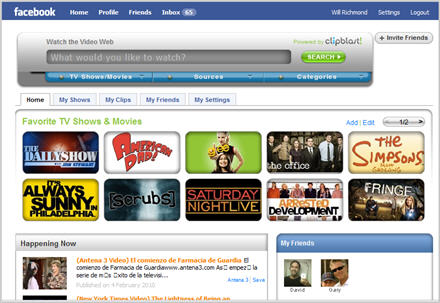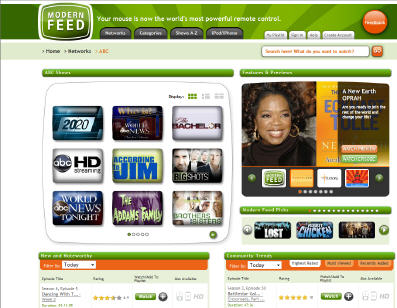-
Watching Hulu Content on Facebook Through ClipBlast's App is Cool
Here's something cool: ClipBlast updated its Facebook app yesterday to now include access to practically all of Hulu's content. ClipBlast's CEO/founder Gary Baker walked me through a demo and I was quite impressed. Once you've added the app, you can favorite certain Hulu shows and they appear as tiles which you can then easily scroll through. It's a huge step forward from Hulu's own mediocre Facebook app. You can also choose video from over 8,500 other sources that ClipBlast offers.
Though I'm personally not a huge Facebook user, the app resonated with me because it makes discovering and sharing video even more powerful as Facebook friends are just a click away. Of course Hulu has offered embedding from the start, but to get almost the whole Hulu library into Facebook, in front of a potential audience of 400 million users is classic "syndicated video economy" thinking. In the SVE, instead of solely trying to bring audience to your content (the traditional media model), efforts are also focused on bringing your content to the audience, wherever they live. All of Hulu's ads flow through as well, so views are still fully monetized. What's missing is full screen viewing, which Gary said is coming shortly.
What do you think? Post a comment now (no sign-in required).
Categories: Aggregators, Syndicated Video Economy, Video Sharing
Topics: ClipBlast, Facebook, Hulu
-
Another Update from the Front Lines of the Syndicated Video Economy
Having staked out the idea of the "Syndicated Video Economy" as a key driver of the broadband video landscape about 6 months ago, I'm continually looking for insights from those companies operating on its front lines. How is it evolving? What are the key challenges and opportunities? How are they being addressed?
I got more feedback yesterday, moderating a session at the Contentonomics conference in LA. On it were:
- Gary Baker, Founder and CEO, ClipBlast
- Jimmy Hutcheson, President, EgoTV
- Damon Berger, Senior Director of Programming & Business Development, Revision3
- Danny Wright, Senior Director, Business Development, Photobucket
Here are a few takeaways I scribbled down during the session:
Revenue issues persist - Jimmy was quick to note that while he's an optimist about syndication, EgoTV's current deals have yet to produce a lot of revenue. I pressed him on the reasons: lack of distributor promotion/traffic, their inability to monetize traffic, both or neither? Jimmy's response was that with so much video flowing through key distributors, gaining solid promotion is a real challenge. A bigger issue is distributors' ability to monetize the traffic they're generating. I've heard this from others as well. This could suggest a continued shift to content providers owning/selling their ad inventory, with distributors focusing mainly on promotion/traffic, and receiving a revenue share for their efforts.
Friction in executing syndication - Though Damon highlighted that Revision3 has 40 distribution partners, that's definitely the exception, not the norm these days; a recurrent SVE theme the panel discussed is the overhead involved in identifying partners, negotiating deals, implementing them, collecting performance stats and doing follow-up analysis. There are no easy answers here. As I've written in the past, some of this just gets resolved as the ecosystem of companies matures.
Brand building takes on greater importance in syndication - There was some consensus on the panel that with content be viewing through multiple outlets, a clear challenge is building a consistent and differentiated brand. The importance of a content provider's own web site magnifies in the SVE. Even though a lot of viewership may occur elsewhere, it's still the best opportunity to control and define the brand for viewers. Further, even if substantial revenues don't materialize from syndication, these deals are still viewed as solid brand-building.
Push to programming quality - As broadband video proliferates, getting noticed is harder than ever. As a result there's a real push to quality video that's underway. In part this involves pulling more high-quality talent into broadband originals. The quality bar is getting ever higher for broadband video especially as better-know talent adopts the medium. Distributors will be in a stronger position to choose which video to include and promote.
That's it for now. I'll keep providing regular updates on the SVE as I gather more information from those fully immersed in it.
What do you think? Post a comment.
(Note: tomorrow's a rare day off for VideoNuze as I observe Yom Kippur)
Categories: Syndicated Video Economy
Topics: ClipBlast, EgoTV, Photobucket, Revision3
-
Pixsy Zeroes in on White-Label Video and Image Search
As the proliferation of broadband video continues apace, the task of finding what you're looking for is only intensifying. That's set off a scramble by many to solve this problem, trying to become in effect, the "Google of video search."
I've previously written about players such as blinkx, Truveo, ClipBlast, Veveo and EveryZing. The latest video search company to hit my radar is Pixsy, which has its own distinctive approach for capturing its share of the growing video search market. I recently spoke with Chase Norlin, Pixsy's CEO to learn more.
Pixsy has three key differentiators:
First, it's purely focused on the B2B white-label opportunity, eschewing the destination site route. Pixsy only wants to power other sites' search capabilities as a white-label provider.
Second, in addition to video search, Pixsy also does image search, which Chase believes is actually the fastest growing part of the search market. Being able to offer image search broadens Pixsy's value proposition to partners, driving enhanced monetization opportunities.
Third, Pixsy doesn't seek to have the broadest index, rather it seeks to balance the breadth of its index with having the most current results. It uses RSS feeds, not web crawlers, to build its index and focuses mainly on current events categories like news, sports and entertainment. Clearly having the most up-to-date results in these kinds of categories is a real plus.
Pixsy's approach seems to be paying off, as it is now powering video and/or image search at sites including
 Veoh, Lycos, PureVideo, National Lampoon and others. This morning it's also announcing a deal with MMORPRG.com, the web's largest massive multiplayer online role playing site.
Veoh, Lycos, PureVideo, National Lampoon and others. This morning it's also announcing a deal with MMORPRG.com, the web's largest massive multiplayer online role playing site. Pixsy works with a number of business models. Sites generating anything under 10K search queries per month can freely use Pixsy's API. Above that volume, Pixsy licenses its index with about a third of partners selling their own ads, and the other two-thirds relying on Pixsy to sell the ads alongside the search results. As Google and others have shown, search results are extremely monetizable.
Based in Seattle and San Francisco, much of Pixsy's team comes from Microsoft and ValueClick. Considering it has been around for about 2 years, has only 15 employees and has raised just an angel round, Pixsy seems to show that the barriers to entry for savvy video search startups can be relatively low. With so many other video search players, I anticipate the category is going to remain fragmented and chaotic for some time to come.
Categories: Video Search
Topics: Blinkx, ClipBlast, EveryZing, Pixsy, Truveo, Veveo
-
ClipBlast Playbox: Video Search and Syndication Wrapped in One
ClipBlast, an up-and-comer in video search, has quietly introduced its "Playbox" feature, which neatly wraps together video search and video syndication, two key mechanisms for increasing video usage. Gary Baker, ClipBlast's CEO gave me a sneak peek a few weeks ago and a demo earlier this week.
Playbox's key differentiator is that it provides a unified video experience across different video providers, while keeping users on-site. When clicking on any result which has video from the web that's embeddable or video from providers that ClipBlast has deals with, a floating window opens on top of the web page.
Playbox plays multiple video format (Flash, WMP, QuickTime) and correctly re-sizes each for the Playbox window. When you click back on the site and select another video it seamlessly loads right into the Playbox window. All of this contributes to a highly unified experience.
While that's pretty cool, the more interesting aspect of Playbox is that it drives frictionless video syndication. Here's how it works:
As ClipBlast distributes its video index and search bar to other sites, Playbox comes along (or not if the site declines it). This means that as ClipBlast's video search migrates from its site to the far corners of the web, Playbox's video syndication spreads too.
Here's an example: say you run a popular blog about auto racing and choose to offer ClipBlast video search and Playbox. A user of the site types "Danica Patrick" into the ClipBlast search bar (for those who missed it, she was the first woman to win an Indy car race, last weekend in Japan).

If the user clicks on the first result with a "Play" icon (with a rollover that says "play this video directly"), Playbox opens. In this example, the first video is from ESPN. When it's over, the user can click the "Details" button and a list of additional, related videos are displayed, from other providers such as AP, VidLife, YouTube, YES Network, etc. The point is that Playbox provides an easy-to-use container where related 3rd party videos can be played without the user ever leaving the auto racing blog.
So Playbox gives videos new exposure throughout the web. Again, if providers code their ads into the file, more views = more revenue. The Playbox window also shows small display ads at the bottom, which ClipBlast monetizes through ad networks. Depending on the video and search term, these slots lend themselves to contextually-targeted ads.
Playbox marries video search and video syndication, and is another mechanism for how video is going to be widely distributed around the web. I expect more of these initiatives to come.
Categories: Video Search
-
Modern Feed Jumps Into Video Navigation Space
With the proliferation of available broadband video comes a massive user navigation challenge. Modern Feed is launching today to address this. It is part search engine, part aggregator, with a specific focus on indexing professionally-produced programming, not user-generated video. It's also focused on actual programs, not promotional clips.
J.D. Heilprin, Modern Feed's founder/CEO told me yesterday that the company is targeting mainstream users providing the easiest way to find available, high-quality video. It employs a team of "Feeders" charged with curating the best videos to include on the site. The result is approximately 550 "networks" and 25,000 pieces of content now indexed, where "networks" is a loose term ranging from traditional broadcasters to indies new entrants like Boston Symphony or Architectural Digest.
Modern Feed is rights-holder friendly, not indexing any illegal or pirated video, and playing the video from the source's site (though sometimes with a thin Modern Feed navigation frame at the top of the screen). I played around with Modern Feed and found it to be easy-to-use and well-laid out. Modern Feed also offers an iPhone implementation that looks pretty cool, other devices are to follow.
The big challenge (and opportunity) for Modern Feed is that it's entering a very noisy space where user behavior is very undefined. There are myriad video search engines (Truveo, ClipBlast, blinkx, Veveo), portals (AOL, Yahoo, MSN), navigation sites (TV Guide, recently-launched PrimeTime Rewind) and of course the networks' own sites (and syndication efforts) offering users the ability to quickly find quality content. Then there's YouTube, the first stop for many users when it comes to video. And YouTube is increasingly moving up market by striking partnerships with premium providers.
Modern Feed's strong user experience, focus on mainstream users and device integrations are differentiators for the company. Whether these are ultimately success factors really depends on how user behavior unfolds in the nascent video navigation space. Modern Feed has raised several million dollars from angels and has 30 full-timers with aggressive growth planned.
What do you think? Post a comment and let everyone know!
See prior posts:
YouTube, C-SPAN Team Up for User-Generated, Multi-Platform Voter Project
Categories: Startups, Video Search
Topics: AOL, Blinkx, ClipBlast, Modern Feed, MSN, PrimeTime Rewind, Truveo, TV Guide, Yahoo, YouTube
Posts for 'ClipBlast'
|




